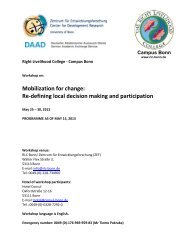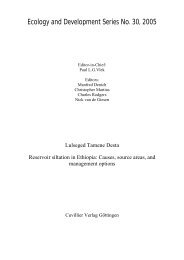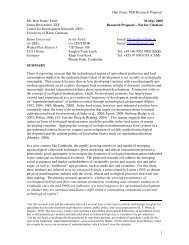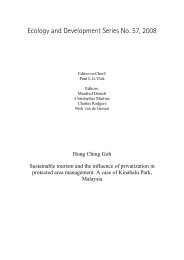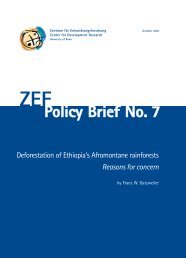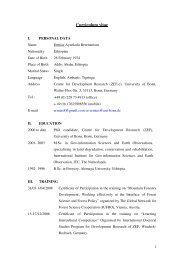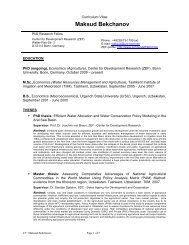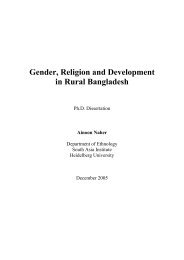Ecology and Development Series No. 10, 2003 - ZEF
Ecology and Development Series No. 10, 2003 - ZEF
Ecology and Development Series No. 10, 2003 - ZEF
- No tags were found...
You also want an ePaper? Increase the reach of your titles
YUMPU automatically turns print PDFs into web optimized ePapers that Google loves.
Impacts of human use on the forest vegetation(1) the frequent disturbance of the forests during management clearing of understoreyvegetation, or (2) lack of enough seed due to harvesting. The micro-climatic conditionscreated by disturbance in the managed forest may not be as suitable for regeneration ofcoffee from seeds. The clearing of the vegetation in the understorey (1-2 times a year) mayexpose the new seedlings to excessive heat from sunlight, which eventually kills them. Orthe farmers harvest all the coffee berries during the fruiting period, which leaves no or onlyfew seeds in such forests. The farmers were even seen collecting the coffee berries that haddropped onto the forest floor after the harvest. When farmers clear the understoreyvegetation around the onset of the harvesting season, they also clear all ground vegetation<strong>and</strong> litter. This is done to facilitate the collection of coffee berries falling to the ground.Total exposure of the mineral soil through removal of the litter layer may also create dry<strong>and</strong> unfavorable micro-climatic germinating conditions for escaped seeds, since the seedsrequire mulch for germination (Purseglove 1968).5.4.4 Implications for conservationConserving biodiversity is one of the greatest challenges to humanity today. Habitatconversion or modification by human beings to produce goods <strong>and</strong> services is the mostsubstantial human alteration of ecosystems threatening biodiversity (Chapin et al. 2000).The current study on Yayu forest shows that managing the forest for coffee production hasmodified the forest vegetation in terms of species diversity, floristic composition <strong>and</strong>structure. The changes in vegetation due to management may have implications for theconservation of coffee genetic resources, overall plant species diversity <strong>and</strong> composition,<strong>and</strong> diversity <strong>and</strong> composition of different animal groups that depend on the forestecosystems.Implications for the conservation of wild coffee populations: As discussedabove, the regeneration capacity of coffee under managed forests has declined, either forbiological or human-induced reasons, or combinations of both. The existing regenerationcapacity in the managed forests may not be sufficient to replace the old trees <strong>and</strong> to thusensure sustainable production in the long term. Information from a local development agentindicates that the mean age of a coffee tree is about 50 years (Tolosa, personal95



